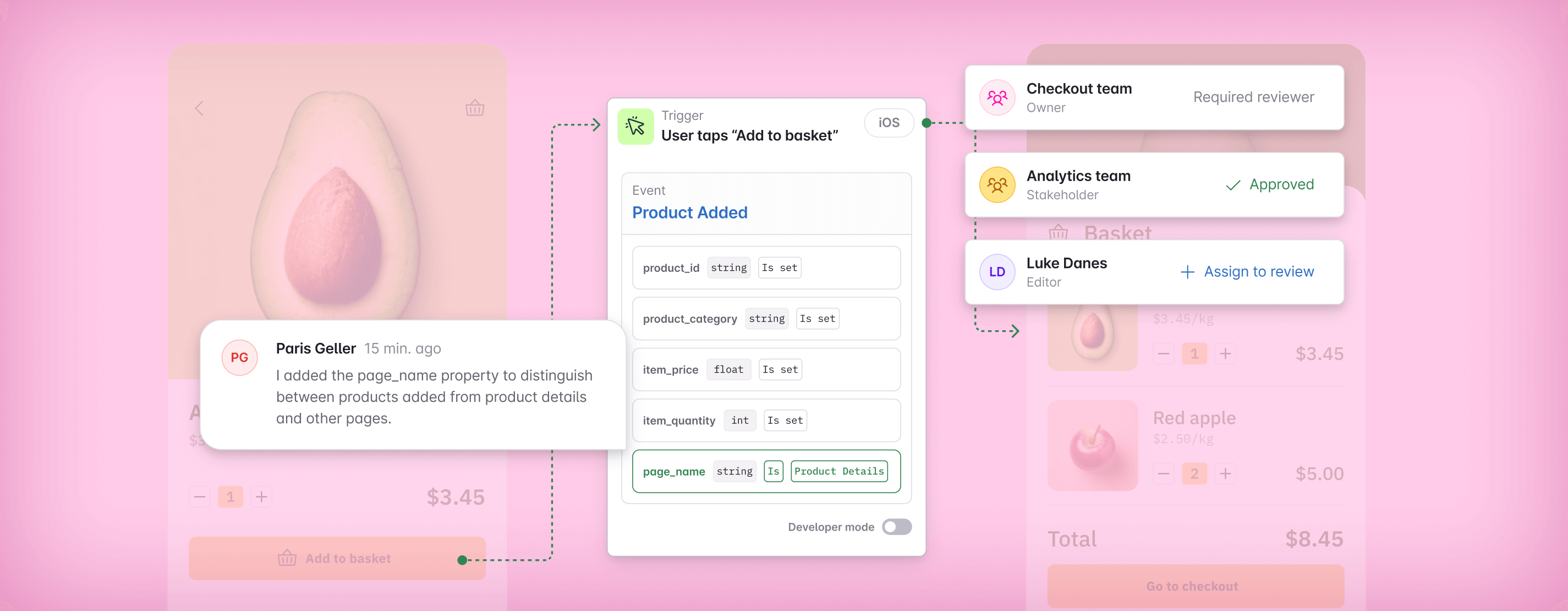In this article
How to Get Everyone in Your Organization on Board with Your Tracking Plan
You know that the secret to stellar data is a best-in-class tracking plan--but what if your leadership hasn't seen the light? Check out our latest to find out how you can get everyone in your organization excited about, and invested in, your tracking plan.
Data-driven business leaders know data is their company’s—and their product’s—most valuable asset. But many of them don't know how this data is generated—and can't help improve how it's collected—because they don't understand the role tracking plans play in overall data governance.
A good tracking plan can mean the difference between unwieldy, hard-to-use data (too much or too little; inconsistent; full of repetitions or errors) and data that helps your organization steamroll its objectives. But you already know that. So let’s talk about how to help your stakeholders understand that, too.
A good tracking plan needs the input and buy-in from everyone in your organization in order to fully align with organizational goals and ensure data design matches them. To get your stakeholders bought into your tracking plan, you need to connect with them early and highlight how your tracking plan will help you collect data to improve your performance and product.
Don't treat your stakeholders as mere bystanders in this quest for good data. Instead, treat them as your teammates, as the supporting cast, and help them understand how and why they should participate in your data plot.
How to shape your tracking plan with your stakeholders
Reach out to your stakeholders early on in the development of your tracking plan to give them a chance to weigh in and influence the plan. A new tracking plan means change, and whatever its nature, no one likes to have change happen to them. Meet for 30 minutes with the owner of each business objective on which you’re basing your tracking plan. The point is to understand the motivation behind the objectives they care about.
One owner might be a CMO motivated by how your product is helping fulfill wider company KPIs relative to adoption rates or churn. Another owner might be a product manager looking to better understand how the feature they’re responsible for is (or is not) driving adoption rates. Other stakeholders may include product leads, engineers, and designers, as well as analytics, marketing, and sales professionals.
Focus on scheduling in-person (or, as is more advisable in present circumstances, virtual) meetings to explain how the tracking plan fits into your company’s data governance. For example, let's say one of your business objectives is to increase average session time in your product. In that case, meet with the product development lead associated with your product.
From there, don't just tell them what preconceived metrics will go into your tracking plan. Find out what data your product development stakeholder would most like to see. What data would best help them solve that recurring issue that gives their team headaches and reduces the quality of their output? Do they need more behavioral data? More qualitative data? Do they need to know more about feature usage or more about bounce rates in certain product areas?
The conversation should be open and two-way. Valuing your stakeholders' ideas and taking their concerns seriously is vital to building a high-functioning tracking plan and building trust in that plan. Trust, needless to say, is an essential component of buy-in.
One-third of the American workforce feels that management officials don’t value their ideas. Your stakeholders should not figure among that number.
The plot treatment: Connect the dots between tracking and objectives
During the early stages of your tracking plan, it's vital that you're demonstrating how that plan will help fulfill stakeholder objectives.
The first step is to be honest about the impacts of inaccurate data. “But,” we hear you say, “isn't inaccurate data what happens when there's no tracking plan in place at all? Stakeholders will be free of having to worry about inaccurate data with this shiny new tracking plan, won't they?”
That's mostly right, and that’s the point you need to convince your stakeholders of. Remember that bad data costs US companies between $9.7 million and $14.2 million annually. It also costs stakeholders gray hairs and sleepless nights. Along with your tracking plan, you’ll also need some way to enforce data governance after its original implementation. But that’s another story for another time.
Once they understand the importance of their stake in your tracking plan, you can discuss how the data you collect will help inform better business decisions to align with these goals.
During your first meeting, identify which business objectives each stakeholder cares about and explain how your tracking plan's events and properties provide support. For example, if you're meeting with product designers, they might identify their principal business objective as “creating a UX that drives more conversions to our premium subscription tier.” An engineering lead might have an objective like “better understanding patterns of search within the product interface.”
Then, with that knowledge, you can demonstrate how your tracking plan will help your designer achieve their objective. It might help them spot premium-ready user types better. You can show your engineers how your tracking plan could help them develop an inventory of search requests and understand which proportion of users is finding the answers to their queries, and which proportion isn’t.
The build-up: Writing the first chapters of your data story
Now that you know what motivates your stakeholders, the fun can begin. To get stakeholders to buy into your tracking plan and feel like it's not just another box to tick on the journey to deployment, you need to set the stage for the kind of story that your new, clean, well-sourced data lets you tell.
Crafting this data story makes it clear to stakeholders how they stand to benefit from maintaining your tracking plan. All of a sudden, helping to develop and use a tracking plan is no longer something stakeholders simply "have to do." It’s something that directly and obviously benefits them.
Once you've identified which business objectives your stakeholder cares most about, work through an example scenario that shows the stakeholder how they might use data to uncover product changes that support better performance post-deployment.
For example, you may have data demonstrating a high bounce rate between your dashboard and your secondary features. This will allow your product development and design stakeholders to streamline their UX. They might implement clearer labeling or redesign on-page buttons to ease passage down the activation funnel. They might go further, reassessing how attractive those secondary features are to your users.
The adventure: Keep engaging stakeholders as your data plot develops
Getting your stakeholders on board is half the battle. The other half is keeping them there. To keep your stakeholders on board with your tracking plan, you need to continue to engage them after the first meeting by giving them updates on your product's performance and letting them know how you're using data to improve it. After all, the thing that will guarantee your team stays onboard with your tracking plan is evidence that it works.
Schedule two or three follow-up meetings with each of your stakeholders, at regular intervals, after deployment. These could fall at time intervals (e.g., a week, 30 days, 90 days) or relative to project milestones (e.g., go live, first product update, second product update, etc.).
For instance, you may wish to meet with your marketing stakeholders at 30, 60, and 90 days following deployment to consider how your tracking plan helped them target and convert the correct buyer personas. You could meet with your engineers and designers a week after each successive product update to review how your tracking plan's information positively impacted their previous round of development choices. This provides an excellent opportunity for stakeholders to add new knowledge and perspective to your tracking plan after your product release.
There are bound to be twists in your data plot; you may not get everything right in the first pass at a tracking plan. (Hint: you definitely won’t, and that’s why version control and branched workflows are important to consider.) Staying dynamic and receptive to stakeholder feedback is crucial for an optimized tracking plan and stable buy-in.
Support your data characters (and tracking plan) better with Avo
Your stakeholders aren’t just non-playable characters in your quest for good data; they’re your comrades in the data battle. To get them excited about the adventure, you need to make it clear how your tracking plan maps to their goals and objectives.
The first step in doing so is good communication. Almost a third of all projects fail because of poor communication: misalignment of objectives, bad or nonexistent knowledge-sharing, and an inability of stakeholders to raise concerns or contribute ideas. Build your tracking plan from stakeholder objectives. Continually feed back the results of your tracking plan to them. It’s all fundamental to gaining and keeping stakeholder buy-in.
You need tools to help make that good communication happen. One of the best ways to collaborate on your tracking plan and make sure everyone is up to date on it is to use a tool like Avo. Avo helps you seamlessly share your data best practices, events, and properties with your team by creating a single source of data truth. With it, your team can look forward to more consistent tracking of manageable volumes of data and an easier route to making better product decisions.
Find out more and try Avo today.
Block Quote

